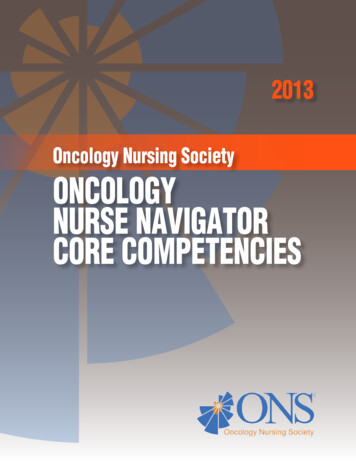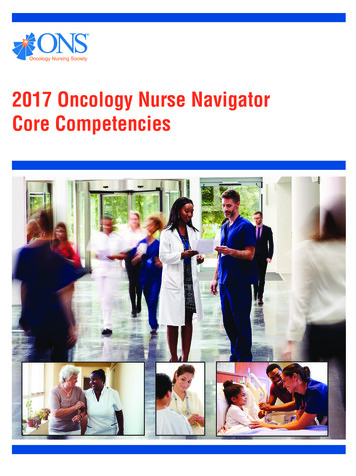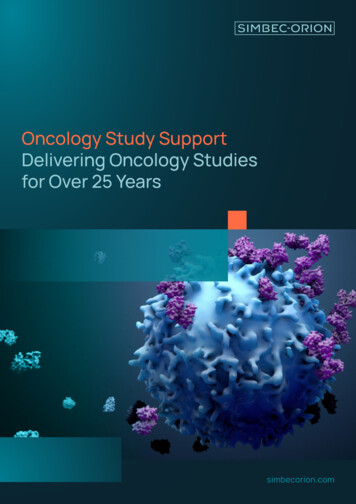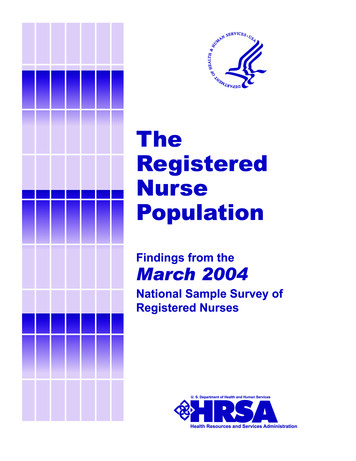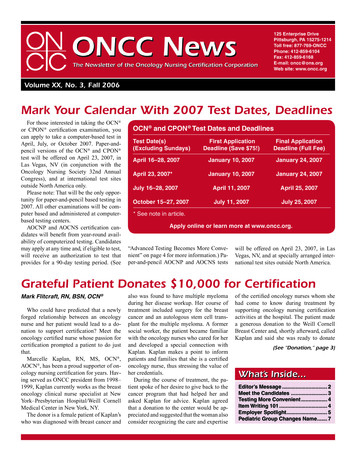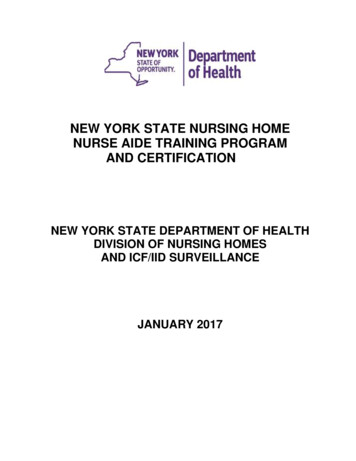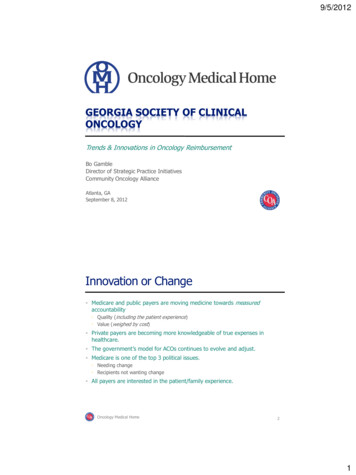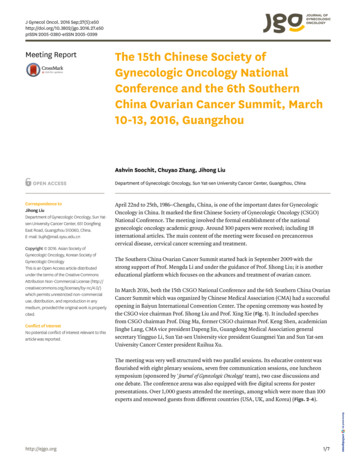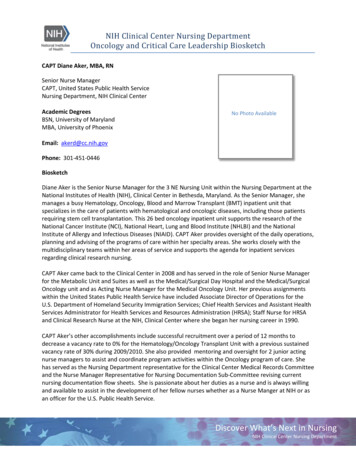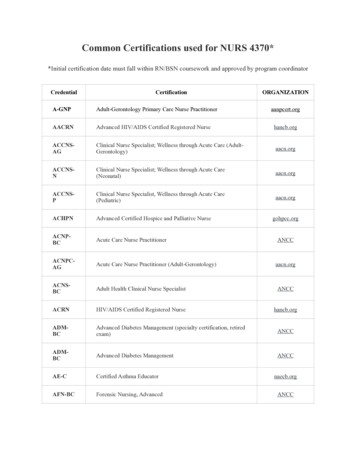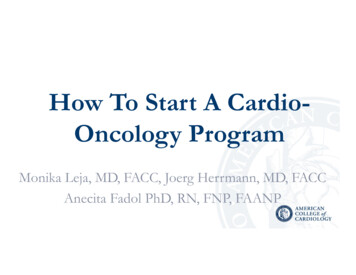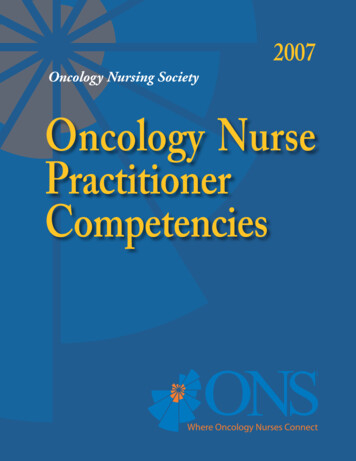
Transcription
ONS Oncology Nurse Practitioner Competencies — 1Oncology Nursing Society2007Oncology NursePractitionerCompetencies
2 — ONS Oncology Nurse Practitioner CompetenciesOncology Nurse Practitioner CompetenciesNational Panel MembersSusan M. Cohen, DSN, APRN, FAANNational Organization of Nurse Practitioner FacultiesJulie A. Ponto, PhD(c), RN, APRN-BC, AOCN Oncology Nursing Certification CorporationKelly A. Goudreau, DSN, RN, CNSNational Association of Clinical Nurse SpecialistsMargaret Quinn Rosenzweig, PhD, APRN-BC,AOCNP University of Pittsburgh School of NursingM. Tish Knobf, PhD, RN, AOCN Yale University School of NursingJoan M. Stanley, PhD, RN, CRNP, FAANAmerican Association of Colleges of NursingDeborah B. McGuire, PhD, RN, FAANUniversity of MarylandStaffLaura Fennimore, RN, MSNOncology Nursing SocietyCynthia Miller Murphy, RN, MSN, CAEOncology Nursing Certification CorporationBarbara Sigler, RN, MNEdOncology Nursing SocietyCopyright 2007 by the Oncology Nursing Society. All rights reserved. For permission to reprint, adapt, post online, orotherwise reuse at your institution, please email pubpermissions@ons.org.
ONS Oncology Nurse Practitioner Competencies — 3Validation PanelPat Wills Alcoser, MSN, CPNPBaylor College of Medicine/Texas Children’s HospitalPam Malloy, MSN, RN, AACNAmerican Association of Colleges of NursingDeborah H. Allen, RN, MSN, FNP, APRN-BC, AOCNP Duke Comprehensive Cancer CenterJudie Much, APNC, AOCNP The Cancer Institute of New JerseyKaren Brown, FNP-C, ONPRoswell Park Cancer InstituteRosemary Neider, RN, MSN, APRN-BC, AOCN University of Wisconsin Hospital and ClinicsKathleen Calzone, RN, MSN, APNGInternational Society of Nurses in GeneticsMary Baron Nelson, MS, RN, CPNP, CPON Association of Pediatric Hematology/Oncology NursesCathy J. F. Cole, RNC, NP, MPH, CHESCooper Finkel Women’s Health CenterJean Ridgeway, APN, NP, MSN, AOCN University of Chicago Medical CenterJoan O’Hanlon Curry, RN, MS, CPNP, CPON The Children’s Hospital at MontefioreCheryl Rodgers, MSN, CPNPBaylor College of Medicine/Texas Children’s HospitalLynn Czaplewski, RN-BC, CRNI, BSN, OCN Infusion Nurses SocietyBarbara Barnes Rogers, CRNP, MN, AOCN Fox Chase Cancer CenterMarie Flannery, RN, PhDJames P. Wilmot Cancer CenterUniversity of Rochester Medical Center and School ofNursingVictoria Sinibaldi, RN, MS, CS, CRNP-BC, AOCN Johns Hopkins University School of Medicine/JohnsHopkins HospitalJanet Wyatt, PhD, CRNPPediatric Nursing Certification BoardCathy Haut, MS, CPNPPediatric Nursing Certification BoardMichele M. Hughes, RN, MSN, ACNP, ONP-COrthopaedic Nurses Certification BoardLisa M. Zajac, MSN, APRN-BC, OCN Barbara Ann Karmanos Cancer InstituteRobin King, MSN, CS, ACNPBarbara Ann Karmanos Cancer InstituteEndorsementsThe following organizations endorse the Oncology Nurse Practitioner Competencies.American Nurses Credentialing Center, Commission on AccreditationEmergency Nurses AssociationHospice and Palliative Nurses AssociationInfusion Nurses Society
4 — ONS Oncology Nurse Practitioner CompetenciesTable of ContentsProject ces.7Oncology Nurse Practitioner Competencies.8I. Health Promotion, Health Protection, Disease Prevention, and Treatment.8II. Nurse Practitioner-Patient Relationship . .12III. Teaching-Coaching Function.12IV. Professional Role .12V. Negotiating Healthcare Delivery Systems.13VI. Monitoring and Ensuring the Quality of Healthcare Practice.14VII. Caring for Diverse Populations.14Appendix A. Bibliography. 15
ONS Oncology Nurse Practitioner Competencies — 5Project OverviewIntroductionThe American Cancer Society (ACS) estimates that 1,444,920 new cases of cancer will be diagnosed and that 559,650Americans will die of cancer in 2007 (ACS, 2007). Although survival rates continue to climb, cancer remains the secondmost common cause of death in the United States, exceeded only by heart disease. Those who survive cancer often continueto receive treatment and require close follow-up care and surveillance. The National Cancer Institute (NCI) estimatesthat approximately 10.5 million Americans with a history of cancer were alive in 2003. Some were cancer-free, whereasothers still had evidence of cancer and may have been undergoing treatment (ACS). A significant number of advancedpractice registered nurses (APRNs) provide care to patients with a past, current, or potential diagnosis of cancer, andvery distinct competencies are required to provide this care. As of May 2007, the membership of the Oncology NursingSociety (ONS) included 2,024 oncology nurse practitioners (ONPs).ProcessThe Oncology Nurse Practitioner Competencies reflect the work of a multi-organizational national panel. In 2005,ONS convened the panel, representing six national nursing organizations whose foci include advanced practice registered nursing education, oncology nursing practice, and certification of oncology nurse practitioners. Additional educators and practitioners were included on the national panel. ONS facilitated the work of the national panel through threephases that encompassed development, field review by practicing ONPs, and external validation of the competencies.The process used for this project models that used for the development of the Nurse Practitioner Primary Care Competencies in Specialty Areas: Adult, Family, Gerontological, Pediatric, and Women’s Health (National Organization ofNurse Practitioner Faculties [NONPF] & American Association of Colleges of Nursing, 2002) and the Acute Care NursePractitioner Competencies (NONPF, 2004).The national panel convened for the first time in February 2005 at the ONS National Office in Pittsburgh, PA. During this meeting, the group reviewed the existing body of work, including standards of practice for oncology APRNsand existing competencies for nurse practitioners (see Appendix A) and began drafting the competencies. The nationalpanel agreed that the Oncology Nurse Practitioner Competencies would build upon the core competencies for all nursepractitioners, and the panel agreed to use the same framework as that used for the primary care competencies in specialtyareas.Following the first meeting, the group convened several times by conference call to continue the work. A secondmeeting was held in April 2005, which again was followed by conference calls to complete phase one of the project,development of a set of consensus-based competencies for all ONPs by the national panel.In September 2005, phase two of the project, the field review, was initiated. All ONS members who were nursepractitioners (approximately 1,800) were invited electronically to review the document and evaluate the Specificity of each competency, answering the question, Is the competency stated specifically and clearly? And if not,nurses could provide suggested revisions. Relevance of each competency, answering the question, Is the competency necessary for entry-level ONPs? Comprehensiveness of the document, providing any missing knowledge, skill, or attribute of the entry-levelONP.Approximately 350 ONPs requested a copy of the document to review, and 127 completed reviews were received.The field review demonstrated general consensus with the majority of the competencies and provided valuable feedbackfor refinement, particularly in the area of specificity. Following the field review, a series of conference calls were heldwherein the national panel reviewed the comments from the field reviewers and revised the document. The revised document was prepared for phase three, and the validation process was begun in the summer of 2006.The validation panel included 21 individuals identified as having expertise related to ONP practice. Individuals werenominated to complete the validation process by a wide range of specialty nursing organizations, certifying bodies, andNCI-designated comprehensive cancer centers.The individuals on the validation panel were identified as having experience in one or more of the following areasrelated to the nurse practitioner role or scope of practice:
6 — ONS Oncology Nurse Practitioner Competencies Delivery of oncology careEducation of ONPsCredentialing of ONPsAccreditation of graduate nursing education programs.The validation panel members were invited to review and evaluate the document using the same tool that the fieldreviewers used and answer the same questions related to specificity, relevance, and comprehensiveness. The validationprocess demonstrated general agreement with the competencies and provided valuable feedback for additional revisionsand refinement. The national panel was again convened during a series of conference calls to review the feedback fromthe validation panel and revise the competencies. Based on the feedback, approximately 20% of the competencies underwent revision to enhance their specificity, and five competencies were added and seven competencies were deletedbecause of redundancy or consensus that they were not required for entry-level ONPs. Following the final revisions, thedocument included 103 entry-level competencies expected of all ONPs.At the completion of the validation phase and consensus by the national panel on the final competencies, ONS distributed the document for endorsement by national nursing organizations that have a stake in oncology care and advancedpractice registered nursing. The endorsement process remains fluid so that additional endorsers can be added to theelectronic posting of the competencies. The competencies will be available to all endorsing organizations for electronicposting on Web sites. The intent is for widespread dissemination of the competencies to promote global recognition ofthe competencies as quality indicators for ONPs’ entry into practice.OverviewThis document describes entry-level competencies for ONPs who care for adults and late adolescents. Graduateprograms that prepare ONPs include broad educational preparation in advanced pathophysiology, pharmacology, andadvanced physical assessment (AACN, 1996), as well as the specific coursework and clinical experiences required toprepare graduates to care for patients with a past, current, or potential diagnosis of cancer. These competencies areintended to be used in conjunction with and build upon the core competencies identified for all nurse practitioners (seeAppendix A). Upon graduation from a graduate oncology nurse practitioner program or entry into advanced oncologynursing practice, the ONP should demonstrate the competencies described in this document.The competencies in this document emphasize the unique philosophy of practice for the ONP specialty and theunique needs of patients with a past, current, or potential diagnosis of cancer. ONPs are educationally prepared to provideadvanced nursing care to meet the specialized physiologic and psychological needs of patients throughout the continuumof care, including cancer prevention and detection, cancer diagnosis and treatment, rehabilitation, survivorship, and endof-life care. Although individual ONPs may focus their practice on a particular stage in the continuum, they are preparedto provide primary, acute, and palliative care to patients with cancer, including the application of knowledge of geneticsand genomics. As ONPs gain experience, their practice may include more advanced and additional knowledge, skills,and abilities not included in these entry-level competencies.ONPs provide care in a variety of primary, acute, and tertiary settings, including comprehensive cancer care centers,urban and rural community hospitals, ambulatory and medical mobile clinics, private physician/nurse practices, community health centers, home care, palliative care settings, hospices, rehabilitation centers, and extended care facilities.ONPs provide care to specific populations in cancer prevention, screening, diagnosis, active treatment, palliative care,and rehabilitation in conjunction with the multidisciplinary healthcare team. The ONP’s role includes the assessment,diagnosis, and management of cancer and related disorders. The ONP uses evidence-based literature and works towardevidence-based practice to effect a positive change in the health of and healthcare delivered to the patient with a past,current, or potential diagnosis of cancer.Throughout this document, the term patient refers to adult and/or late adolescent individuals, their families, unrelatedsignificant others and caregivers, and/or the community.These competencies, in addition to the core competencies (NONPF, 2006) for all nurse practitioner practice, reflectthe current knowledge base and scope of practice for entry-level ONPs. As scientific knowledge expands and the healthcare system and practice change, the nurse practitioner competencies will evolve. These competencies will periodicallybe reviewed and updated to reflect scientific advances and evidence-based changes in practice.
ONS Oncology Nurse Practitioner Competencies — 7ReferencesAmerican Association of Colleges of Nursing. (1996). The essentials of master’s education for advanced practice nursing. Washington, DC: Author.American Cancer Society. (2007). Cancer facts and figures, 2007. Atlanta, GA: Author. Retrieved May 18, 2007, from http://www.cancer.orgNational Organization of Nurse Practitioner Faculties. (2004). Acute care nurse practitioner competencies. Washington, DC: Author.National Organization of Nurse Practitioner Faculties. (2006). Domains and core competencies of nurse practitioner practice. Washington, DC: Author.National Organization of Nurse Practitioner Faculties & American Association of Colleges of Nursing. (2002). Nurse practitioner primary care competencies in specialty areas: Adult, family, gerontological, pediatric, and women’s health. Washington, DC: National Organization of Nurse PractitionerFaculties.
8 — ONS Oncology Nurse Practitioner CompetenciesOncology Nurse Practitioner CompetenciesI. HEALTH PROMOTION, HEALTH PROTECTION, DISEASE PREVENTION, AND TREATMENTA. Assessment of Health StatusThese competencies describe the role of the oncology nurse practitioner (ONP) in assessing all aspects of thepatient’s health status, including for purposes of health promotion, health protection, and disease prevention.The ONP uses evidence-based clinical practice guidelines when available to guide screening activities, identifyhealth promotion needs, and provide anticipatory guidance and counseling, addressing environmental, lifestyle,and developmental issues.1. Obtains and documents a comprehensive health history for patients with a past, current, or potentialdiagnosis of cancer2. Uses evidence-based practice guidelines and assessment tools for evaluating patients with a past, current,or potential diagnosis of cancer3. Performs a relevant cancer risk assessment for: General populationsAt-risk populationsNewly diagnosed patients with cancerCancer survivors4. Obtains comprehensive information related to risk, diagnosis, and past experience with cancer5. Performs and documents complete, system-focused, symptom-specific physical examinations for patients6. Performs a physical assessment of patients with cancer that includes a comprehensive review of systemsand evaluation of manifestations and toxicities related to cancer and its treatment7. Assesses actual or potential late effects of cancer and its treatment (e.g., second malignant neoplasms,cardiomyopathy, pulmonary dysfunction) in cancer survivors8. Assesses the impact of physical comorbidities on cancer symptoms and response to treatment9. Identifies the relationship between normal physiology and specific system alterations produced by cancerand cancer treatment10. Assesses symptoms commonly seen in patients with cancer (e.g., fatigue, pain, nausea, vomiting)11. Assesses for common signs and symptoms related to disease progression or recurrence12. Assesses patients who are at high risk for signs and symptoms of oncologic emergencies13. Performs a comprehensive assessment of nutritional status in patients with a current or past diagnosis ofcancer
ONS Oncology Nurse Practitioner Competencies — 914. Conducts a pharmacologic assessment, including over-the-counter medications, prescription drugs,nutritional supplements, and other complementary, alternative, and integrative therapies, to identify andcorrect any potential interactions with cancer therapeutics15. Assesses the risks of polypharmacy to the patient’s health16. Performs a comprehensive assessment of functional status and the impact on activities of daily living,including but not limited to the following domains PsychologicalRoleSocialCognitivePhysical17. Assesses for the presence of psychological comorbidities (e.g., anxiety/depression, substance use), pastand present coping skills, and the psychosocial impact of the cancer experience18. Assesses concerns and issues related to sexual function, sexual well-being, and fertility of patients witha past, current, or potential diagnosis of cancer, including the impact on relationships19. Assesses developmental, ethnic, spiritual, racial, socioeconomic, and gender variations in symptom presentation or illness experience of patients with cancer20. Assesses the roles, tasks, and stressors of individuals, families, and caregivers and their ability to managethe illness experience (e.g., resources, support services, equipment, transportation, child care, anxiety,depression)21. Assesses patients’ ability to navigate the complex healthcare system and the barriers to continuity, coordination, and communication among multiple care providersB. Diagnosis of Health StatusThe ONP is engaged in the diagnosis of health status. This diagnostic process includes critical thinking, differential diagnosis, and the integration and interpretation of various forms of data.1. Orders screening, diagnostic, and surveillance examinations or tests2. Demonstrates knowledge of technical skills needed to perform diagnostic procedures to confirm or ruleout health problems (e.g., bone marrow aspirations, spinal taps, skin biopsies)3. Performs an initial interpretation of laboratory studies and diagnostic tests, including but not limited tochest x-ray or electrocardiogram4. Reviews diagnostic and laboratory study results to confirm or rule out health problems5. Demonstrates knowledge of atypical presentations of cancer6. Demonstrates understanding of the principles of cancer staging7. Collaborates with relevant healthcare team members and gathers additional information for further differential diagnosis and problem identification
10 — ONS Oncology Nurse Practitioner Competencies8. Diagnoses common episodic, acute, and chronic physical problems in patients with a past or currentdiagnosis of cancer9. Diagnoses acute and chronic conditions that may result in rapid physiologic deterioration or life-threatening instability, including oncologic emergencies10. Identifies the need for screening for common late effects in cancer survivors (e.g., infertility, cardiomyopathy)11. Reformulates diagnoses based on new or additional assessment data12. Determines the impact of comorbidities on the prognosis and treatment of patients with cancer13. Diagnoses acute and chronic psychological complications (e.g., anxiety, depression, substance abuse) andtheir influence on the patient’s psychological state14. Documents diagnoses and problems to facilitate identification and initiation of the treatment plan andoutcome evaluation15. Demonstrates knowledge of diagnostic and procedural coding documentation requirementsC. Plan of Care and Implementation of TreatmentThe objectives of planning and implementing therapeutic interventions are to return the patient to a stablestate and to optimize the patient’s health. These competencies describe the ONP’s role in managing the patient,minimizing physical and psychological complications, and maximizing the patient’s health potential.Plan of Care1. Collaborates with the multidisciplinary team, patient, family, and caregivers to formulate a comprehensiveplan of care for patients with cancer, including appropriate health education, health promotion and healthmaintenance, rehabilitation, and palliative care2. Plans for the management of common cancer-related episodic, acute, and chronic problems3. Plans for the management of cancer and cancer treatment–related symptoms (e.g., pain, nausea/vomiting,neuropathies, infection)4. Integrates evidence-based, nonpharmacologic treatment modalities into the plan of care5. Plans therapeutic interventions to restore or maintain an optimal level of functioning6. Establishes a comprehensive plan of care as patients transition from active treatment to cancer survivorship or end-of-life care7. Plans for long-term evaluation and management of late effects of treatment8. Coordinates care with attention to resource availability, accessibility, quality, and cost-effectiveness9. Coordinates care within a context of functional status, cultural considerations, spiritual needs, family orcaregiver needs, and ethical principles
ONS Oncology Nurse Practitioner Competencies — 1110. Demonstrates awareness of appropriate clinical trials and research studies for which patients may beeligible and assists in recruiting patients as appropriate11. Incorporates patients’ developmental learning needs and preferences in planning patient and family teaching12. Documents the plan of care and intended outcomes to ensure that interventions will be implemented asplannedImplementation1. Uses evidence-based strategies in the management of patients across the continuum of care (i.e., prevention, early detection, diagnosis, treatment, rehabilitation, survivorship, and end-of-life care)2. Monitors and manages the effects of cancer and cancer treatment3. Provides anticipatory guidance to assist patients and families in coping with the illness and its potentialor expected outcomes4. Considers comorbid conditions when implementing cancer treatment5. Treats episodic, acute, and chronic health problems6. Initiates appropriate treatments and referrals for patients experiencing an oncologic emergency (e.g., disseminated intravascular coagulation, superior vena cava syndrome, spinal cord compression)7. Implements interventions to support patients who have a rapidly deteriorating physiologic condition, including the application of basic and advanced life support and other invasive interventions or proceduresto regain physiologic stability8. Educates and supports patients in self-care strategies9. Refers patients to other healthcare providers for further evaluation as appropriate10. Refers patients and families to appropriate support services11. Facilitates transitions between healthcare settings to provide continuity of care12. Uses an ethical framework in all aspects of patient care to assist patients, families, and other caregivers onissues related to the care and management of symptoms, advance directives, and palliative and end-of-lifecare13. Coordinates palliative and end-of-life care in collaboration with patients, families, caregivers, and othermembers of the multidisciplinary healthcare team14. Evaluates the effectiveness of interventions and revises the plan of care as appropriate15. Determines the impact of cancer treatment and its side effects and long-term effects on patient outcomes
12 — ONS Oncology Nurse Practitioner CompetenciesII. NURSE PRACTITIONER-PATIENT RELATIONSHIPCompetencies in this area demonstrate the personal, collaborative, and therapeutic approach, which enhances theeffectiveness of the ONP’s patient care. These competencies speak to the critical importance of interpersonal transactions as they relate to patient outcomes.1. Establishes caring relationships with patients, families, and other caregivers to facilitate coping with sensitiveissues2. Facilitates patient and family decision making regarding complex treatment, symptom management, and endof-life care3. Assists patients with cancer and their families in preparing for and coping with grief and bereavementIII. TEACHING-COACHING FUNCTIONThese competencies describe the ONP’s teaching function, which is to impart knowledge and skills for self-care tothe patient. The coaching function involves the skills of advocacy, support, and reinforcement.1. Develops interventions with patients and families that are consistent with patients’ physiologic and psychological needs and values2. Uses age-appropriate learning principles in patient, family, and caregiver education3. Educates patients, families, caregivers, and the community about cancer risk, screening, and early detection4. Uses evidence-based information to help patients with cancer and their families to make informed decisions5. Provides information to patients and families to facilitate adherence to cancer treatment, supportive care, andfollow-up6. Educates patients and families about expected and potential adverse effects and costs (as appropriate) of prescribed pharmacologic and nonpharmacologic treatments and interventions7. Educates cancer survivors regarding their risk for long-term effects of cancer and its treatment (e.g., secondmalignant neoplasm, skin cancer, cardiopulmonary complications)8. Facilitates patient decision making by explaining treatment alternatives and potential outcomes, including theoption of discontinuing active cancer treatment while optimizing supportive care9. Educates patients and families on the risks and benefits of alternative, integrative, and complementary therapies,including possible adverse interactions with standard and investigational cancer therapiesIV. PROFESSIONAL ROLEThese competencies describe the varied role of the ONP, specifically related to advancing the profession and enhancing direct care and management. The ONP demonstrates a commitment to the implementation, preservation,and evolution of the ONP role.1. Builds collaborative, interdisciplinary relationships to provide optimal care to patients with cancer
ONS Oncology Nurse Practitioner Competencies — 132. Promotes life-long learning and evidence-based practice while continually acquiring knowledge and skillsneeded to improve patient care3. Recognizes the importance of participation in community and professional organizations that influence cancercare and support the role of the ONP4. Contributes to the knowledge base of the healthcare community through community outreach, involvement inprofessional organizations, presentations, publications, and participation in research5. Maintains professional competence and credentials appropriate to the role and specialty6. Disseminates knowledge required to care for patients with cancer to other healthcare workers and caregiversthrough peer education, staff development, mentoring, and preceptor experiences7. Translates research findings and other evidence for other healthcare professionals to improve the care of patientswith cancer8. Promotes the role of the ONP and its significance in improving patient outcomes to the healthcare team, thirdparty payers, regulators, legislators, and the public9. Participates in clinical and nursing research to promote positive outcomes for patients with cancer and theircaregivers10. Advocates within the healthcare system and policy arenas for the health needs of patients with cancerV. NEGOTIATING HEALTHCARE DELIVERY SYSTEMSThese competencies describe the ONP’s role in achieving improved health outcomes for patients, communities,and systems by overseeing and directing the delivery of clinical services within an integrated system of healthcare.1. Assists patients with cancer and their families and caregivers to negotiate healthcare delivery systems2. Creates and enhances positive, health-promoting environments that maintain a climate of dignity and privacyfor patients with cancer3. Identifies aspects of the healthcare system that create barriers to comprehensive cancer care and long-term carefor cancer survivors4. Incorporates knowledge of payment and reimbursement systems and financial resources into the plan of carefor patients with cancer5. Documents clinical services provided in accordance with reimbursement regulations and guidelines6. Adheres to institutional, state, and federal laws and regulations related to the care of patients with c
University of Chicago Medical Center. Cheryl Rodgers, MSN, CPNP. Baylor College of Medicine/Texas Children's Hospital. Barbara Barnes Rogers, CRNP, MN, AOCN. . & American Association of Colleges of Nursing, 2002) and the . Acute Care Nurse Practitioner Competencies (NONPF, 2004).
